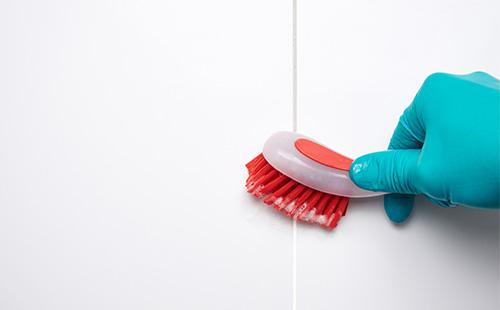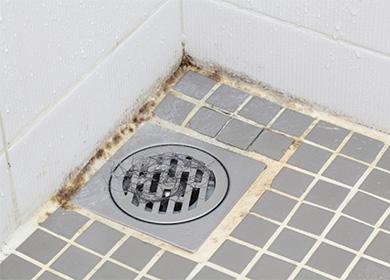The content of the article
It is believed that typical apartments are poorly adapted for people's lives. But for mold life, they are ideally suited. There are five main reasons for the appearance of fungus in the bathroom.
- High humidity. It is impossible to create a perfectly dry environment in a room with a bathtub, washbasin, water pipes, washing machine and other attributes associated with water. And high importance is the main condition for the formation and reproduction of the fungus.
- Lack of natural light. With rare exceptions, the bathrooms of urban apartments are closed “boxes” without window openings. They do not get sunlight, which inhibits the development of mold.
- Heat. Hot water is constantly circulating in the bathroom, and a heated towel rail can also work. All this creates a warm microclimate favorable for the fungus.
- The presence of gaps.There are many gaps in the bathroom where water may linger. Most often, mold forms under the bathtub, behind the washing machine, under plastic panels, at the joints between the tiles.
- Air stagnation. The problem is associated not only with the lack of windows, but also with the poor state of the ventilation system.
The main thing about the problem
Interestingly, mold appeared about 200 million years ago. The fungus successfully survived both the ice age and the abnormal heat. And even in areas with an active radiation background, where other flora and fauna die, scientists discover a large amount of spreading mold. It is unpleasant and even scary to have such a "neighbor" in your bathroom. How to wash and destroy blackness with your hands in an apartment?
Species characteristics
Black, blue, red, white, fluffy ... It is difficult to say what this muck does not happen. Removing damp from the walls is hard work. What determines the color and texture, how to clean and what types of mold there are, the following table will show.
Table - Description of the types of mold
| Colour | Development conditions | What does it look like |
|---|---|---|
| Black and gray mold | - Premises with high humidity | - Local or grouped black spots - in the early stages, the fungus is colorless |
| White mold | - Food; - soil of indoor plants; - wet surfaces | - White plaque with a fibrous texture; - fluffy surface |
| Blue green or blue mold | - Wood and other natural materials; - brick; - soil of indoor plants; - Food | - Blue or green plaque with a heterogeneous texture |
| Pink mold or red mold | - Plants; - products of decay | - Matte coating; - fluffy texture |
What is the danger
The fungus not only spoils the appearance of the finish, but also destroys the structure of materials.But this is nothing compared to what harm disputes can cause to human health. What is dangerous mold in the bathroom? It can cause such problems:
- skin rashes;
- eczema;
- hair loss;
- nail fungus;
- fatigue and lethargy;
- frequent headache attacks;
- chronic runny nose;
- cough;
- conjunctivitis;
- bronchial asthma;
- intoxication of the body;
- rheumatic pains;
- digestion disorder;
- internal bleeding.
How to get rid of mold in the bathroom: 7 remedies
If you notice mold in the bathroom, it does not mean that you have to do repairs or carry out processing with expensive compounds. In the kitchen, in the first-aid kit or in the nearest hardware store, there is surely one of seven remedies that can help remove fungus in the bathroom.
Vinegar
- Pour table vinegar (9%) into a spray bottle. Determine the amount of fluid yourself based on the area of the affected surface.
- Sprinkle the problem areas with vinegar abundantly. Wait an hour for the liquid to dry.
- Rub the treated area with a dry, hard brush or a normal rag to remove mold residue.
Hydrogen peroxide
- Apply hydrogen peroxide to areas affected by the fungus. Wipe the vertical surfaces with a cloth soaked in a solution. On a horizontal plane, the product can simply be poured.
- Do not use the bathroom for an hour and a half until the surfaces are completely dry.
- Rub the treated area with a brush or dry cloth.
Ammonia
- Dilute ammonia in equal amounts with water.
- Pour the composition into a container with a spray gun and treat problem surfaces.
- After two hours, rinse off ammonia and wipe dry.
Soda
- Dissolve a tablespoon of soda in 250 ml of water.
- Wipe the infected area with a sponge dampened in a solution, or sprinkle from a spray bottle.
- When the soda solution dries, rinse it and wipe the treated surfaces dry.
Furatsilin
- Powder 20 tablets of furatsilin.
- Pour a glass of warm water into a container with a spray bottle, add the product and twist.
- Shake the bottle until the powder is completely dissolved.
- Spray the composition on moldy surfaces.
- After 30-40 minutes, wipe with a dry cloth.
Blue vitriol
- Copper sulfate from mold in the bathroom is used by dissolving in ten parts of water.
- Using a hard brush, distribute the solution to the places where the fungus has appeared, and around them.
- After an hour, rinse several times with water to completely remove the remaining substance.
- Wipe surfaces with a dry cloth and ventilate.
Boric acid
- Dissolve boric acid (500 g) in 10 l of water.
- You can use the solution in undiluted form, but to increase efficiency it is recommended to add a couple of tablespoons of vinegar and 500 g of borax powder.
- Sponge or spray on affected surfaces.
- After two to three hours, rinse with water and wipe off moisture.
Receptions on different surfaces
How to handle a mold bath? Suitable folk remedies or store antiseptics. But some surfaces require special attention and a specific approach.
Tile joints
Before the hostess has time to admire the neat new tile bordered with white grout, the insidious fungus begins to stain the seams in black, red and green. If you are determined to remove mold in the bathroom at the seams of the tiles at home, you must strictly follow the instructions.
Treatment
- Determine the location of the fungus honey tiles. After a careful inspection of the surface, make notes with a bright marker so as not to lose sight of anything.
- Using sandpaper or a metal brush, remove the darkened grout. You also need to remove the coating around the fungal spots, even a clean-looking grout may contain fungal spores.
- On the cleaned areas, apply whiteness and warm the surface to kill the remains of the fungus. Use a soldering iron. In the absence of the latter, a hairdryer can be dispensed with.
- Prepare a grout mixture and apply it to the chlorine-treated areas. When the composition is dry, remove excess with a sponge.
- At the last stage, you should block mold access to the grout surface. To do this, the space between the tiles must be covered with transparent varnish.

Tile
How to deal with mold in the bathroom on the tile? Essential oil will help.
Treatment
- In two glasses of water, dilute a tablespoon of tea tree ether.
- Pour the liquid into the spray bottle and shake the container well.
- When all family members have completed the water procedures, sprinkle the tile with the solution and leave it overnight.
- In the morning, wipe the surface with a dry cloth.
Sealant
To remove mold in the bathroom on the sealant, use peroxide with vinegar and boric acid.
Treatment
- In four norms of water, dilute three norms of vinegar, two - peroxides and the norm of boric acid.
- Soak the sponge in the mixture and rub the surface well.
- After 20 minutes, rinse and wipe the sealant dry.
- Ventilate and do not use the room for five to six hours.
Ceiling
Getting rid of mold on the ceiling in the bathroom is no easy task. The surface is inconvenient to process. In addition, the fungus quickly penetrates deep into concrete through a thin barrier of whitewash or paint. To combat mold on the ceiling, it is recommended to use an antiseptic impregnation, which can be purchased at a hardware store.
Treatment
- Carefully inspect the ceiling to identify moldy areas. Outline them with a pencil or marker.
- Remove surface finish (coat of paint, whitewash or other material). If mold is under the tile, it must also be removed.
- To prevent mold spores from flying into the air, dampen the ceiling with spray water.
- Spray antiseptic. It is applied not only to the marked areas, but also half a meter beyond them.
- When the product has dried, apply an antiseptic again.
- Brush the surface with a wire brush or scraper.
- Re-treat with an antiseptic.
- It remains to putty the ceiling and perform the necessary finishing.
So that the muck does not start
Whatever mold recipe you choose, the process of getting rid of the fungus will be time-consuming and lengthy. To avoid having to deal with a problem, pay attention to prevention.
- Ensure normal air circulation. An ideal option would be to install a forced ventilation system.Or try to keep the bathroom door open.
- Wipe the pipes. If you notice any condensation on the pipes, immediately remove it with a dry cloth.
- Keep the plumbing in good condition. Leaking taps are a source of high humidity. As soon as you notice some kind of malfunction, immediately call the plumber.
- Do not tumble dry here. It is better to do this on the balcony or in rooms that are well ventilated.
- Clean the bathroom regularly. It is recommended to use fungicides that will help kill the fungus in its infancy.
- Do the repair correctly. If you plan to change the design of the bathroom, start by treating surfaces with antiseptic agents. In the decoration, use materials containing antifungal components.
Decided how to get rid of fungus and mold in the bathroom? Now take care of your safety. Be sure to wear gloves and a respirator. This will protect the skin and mucous membranes of the respiratory organs from aggressive substances. In addition, this will prevent the inhalation of mold spores that can fly into the air during surface treatment.

